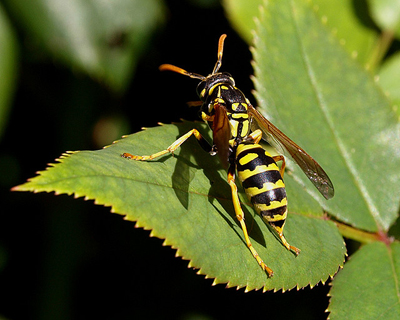Stop Being Bugged! |
|
 |
|
Yellowjacket Wasps
Late summer is the time of year when populations of yellowjackets (commonly called "bees") and other social wasps become large and noticeable. The wasps have been present since spring, but because colonies start as a single queen in May, populations are very small through the early part of the summer. Yellowjacket wasp populations reach a peak at about the time of the Iowa State Fair when each nest may have up to approximately 5,000 wasps. Yellowjackets build paper nests similar to hornets, but either in the ground, a log or landscape timber or building wall or attic. Yellowjackets are commonly observed hovering back and forth at the small nest opening or around garbage cans and other areas where they forage for food. The workers from the colony travel up to a few hundred yards from the nest while looking for food. In the early summer the wasps forage for caterpillars and other "meat" items, but in the fall prefer sweets such as pop and candy residue in garbage cans. Yellowjacket Control If a nest is located where it is out of the way and not likely to be disturbed, it is best left alone. If, however, a nest is located in a "high traffic" area such as along walks or near doorways, control is justified to reduce the threat of being stung. Nests in walls or in the ground can be destroyed by placing an insecticide dust containing carbaryl in and around the nest entrance during the night. The dust particles will adhere to the insects as they leave and reenter the nest and control will usually be achieved within a few days. Do not plug a nest opening in a house wall until you are sure all activity within the nest has stopped. |
|
| Jaime Cantu 641-750-4255 | |
Home | Ants | Asian Lady Beetle | Bed Bugs | Carpenter Ants | Carpenter Bee | Centipede | Earwigs |
|